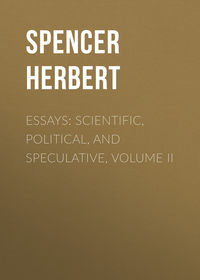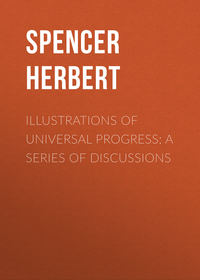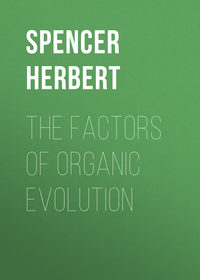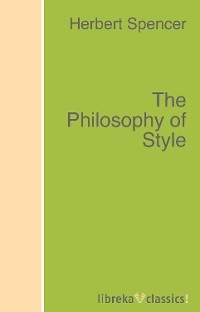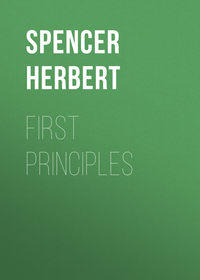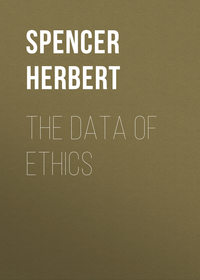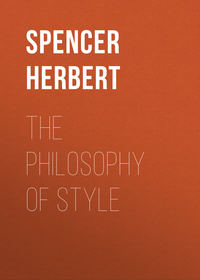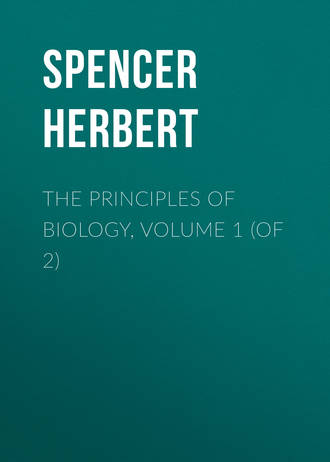 полная версия
полная версияThe Principles of Biology, Volume 1 (of 2)
111
The Transactions of the Linnæan Society of London, Vol. XXII, p. 215. The estimate of Reaumur, cited by Kirby and Spence, is still higher – "in five generations one Aphis may be the progenitor of 5,904,900,000 descendants; and that it is supposed that in one year there may be twenty generations." (Introduction to Entomology, Vol. I, p. 175)
112
A Manual of the Anatomy of Invertebrated Animals, by T. H. Huxley, p. 206.
113
Respecting the Eloidea I learn that in 1879 – thirty years after it had become a pest – one solitary male plant was found in a pond near Edinburgh; but "in an exhaustive inquiry on the plant made by Dr. Groenland, of Copenhagen, he could find no trace of any male specimens having been found in Europe other than the Scotch." In waters from which the Eloidea has disappeared, it seems to have done so in consequence of the growth of an Alga, which has produced turbid water unfavourable to it. That is to say, the decreased multiplication of somatic cells in some cases, is not due to any exhaustion, but is caused by the rise of enemies or adverse conditions; as happens generally with introduced species of plants and animals which multiply at first enormously, and then, without any loss of reproductive power, begin to decrease under the antagonizing influences which grow up.
114
A Text Book of Human Physiology. By Austin Flint, M.D., LL.D. Fourth edition. New York: D. Appleton & Co. 1888. Page 797.
115
This supposition I find verified by Mr. A. S. Packard in his elaborate monograph on "The Cave Fauna of North America, &c.," as also in his article published in the American Naturalist, September, 1888; for he there mentions "variations in Pseudotremia cavernarum and Tomocerus plumbeus, found living near the entrance to caves in partial daylight." The facts, as accumulated by Mr. Packard, furnished a much more complete answer to Prof. Lankester than is above given, as, for example, the "blindness of Neotoma, or the Wood-Rat of Mammoth Cave." It seems that there are also "cave beetles, with or without rudimentary eyes," and "eyeless spiders" and Myriapods. And there are insects, as some "species of Anophthalmus and Adelops, whose larvæ are lacking in all traces of eyes and optic nerves and lobes." These instances cannot be explained as sequences of an inrush of water carrying with it the remote ancestors, some of which did not find their way out; nor can others of them be explained by supposing an inrush of air, which did the like.
116
See "Social Organism" in Westminster Review for January, 1860; also Principles of Sociology, § 247.
117
Contemporary Review, September, 1893.
118
Evolution of Sex, p. 50.
119
Souvenirs Entomologiques, 3me Série, p. 328.
120
Natural History of Bees, new ed., p. 33.
121
Origin of Species, 6th ed., p. 232.
122
Contemporary Review, September, 1893, p. 333.
123
The Entomologist's Monthly Magazine, March, 1892, p. 61.
124
Perhaps it will be alleged that nerve-matter is costly, and that this minute economy might be of importance. Anyone who thinks this will no longer think it after contemplating a litter of half-a-dozen young rabbits (in the wild rabbit the number varies from four to eight); and on remembering that the nerve-matter contained in their brains and spinal cords, as well as the materials for building up the bones, muscles, and viscera of their bodies, has been supplied by the doe in the space of a month; at the same time that she has sustained herself and carried on her activities: all this being done on relatively poor food. Nerve-matter cannot be so very costly then.
125
Loc. cit., p. 318.
126
The Germ Plasm, p. 54.
127
While Professor Weismann has not dealt with my argument derived from the distribution of discriminativeness on the skin, it has been criticized by Mr. McKeen Cattell, in the last number of Mind (October, 1893). His general argument, vitiated by extreme misconceptions, I need not deal with. He says: – "Whether changes acquired by the individual are hereditary, and if so to what extent, is a question of great interest for ethics no less than for biology. But Mr. Spencer's application of this doctrine to account for the origin of species [!] simply begs the question. He assumes useful variations [!] – whether of structure or habit is immaterial – without attempting to explain their origin": two absolute misstatements in two sentences! The only part of Mr. Cattell's criticism requiring reply is that which concerns the "sensation-areas" on the skin. He implies that since Weber, experimental psychologists have practically set aside the theory of sensation areas: showing, among other things, that relatively great accuracy of discrimination can be quickly acquired by "increased interest and attention… Practice for a few minutes will double the accuracy of discrimination, and practice on one side of the body is carried over to the other." To me it seems manifest that "increased interest and attention" will not enable a patient to discriminate two points where a few minutes before he could perceive only one. That which he can really do in this short time is to learn to discriminate between the massiveness of a sensation produced by two points and the massiveness of that produced by one, and to infer one point or two points accordingly. Respecting the existence of sensation-areas marked off from one another, I may, in the first place, remark that since the eye originates as a dermal sac, and since its retina is a highly developed part of the sensitive surface at large, and since the discriminative power of the retina depends on the division of it into numerous rods and cones, each of which gives a separate sensation-area, it would be strange were the discriminative power of the skin at large achieved by mechanism fundamentally different. In the second place I may remark that if Mr. Cattell will refer to Professor Gustav Retzius's Biologische Untersuchungen, New Series, vol. iv (Stockholm, 1892), he will see elaborate diagrams of superficial nerve-endings in various animals showing many degrees of separateness. I guarded myself against being supposed to think that the sensation-areas are sharply marked off from one another; and suggested, contrariwise, that probably the branching nerve-terminations intruded among the branches of adjacent nerve-terminations. Here let me add that the intrusion may vary greatly in extent; and that where the intruding fibres run far among those of adjacent areas, the discriminativeness will be but small, while it will be great in proportion as each set of branching fibres is restricted more nearly to its own area. All the facts are explicable on this supposition.
128
To save space and exclude needless complication I have omitted these passages from the preceding divisions of this appendix.
129
Though Professor Weismann does not take up the challenge, Dr. Romanes does. He says: – "When selection is withdrawn there will be no excessive plus variations, because so long as selection was present the efficiency of the organ was maintained at its highest level: it was only the minus variations which were then eliminated" (Contemporary Review, p. 611). In the first place, it seems to me that the phrases used in this sentence beg the question. It says that "the efficiency of the organ was maintained at its highest level"; which implies that the highest level (tacitly identified with the greatest size) is the best and that the tendency is to fall below it. This is the very thing I ask proof of. Suppose I invert the idea and say that the organ is maintained at its right size by natural selection, because this prevents increase beyond the size which is best for the organism. Every organ should be in due proportion, and the welfare of the creature as a whole is interfered with by excess as well as by defect. It may be directly interfered with – as for instance by too big an eyelid; and it may be indirectly interfered with, where the organ is large, by needless weight and cost of nutrition. In the second place the question which here concerns us is not what natural selection will do with variations. We are concerned with the previous question – What variations will arise? An organ varies in all ways; and, unless reason to the contrary is shown, the assumption must be that variations in the direction of increase are as frequent and as great as those in the direction of decrease. Take the case of the tongue. Certainly there are tongues inconveniently large, and probably tongues inconveniently small. What reason have we for assuming that the inconveniently small tongues occur more frequently than the inconveniently large ones? None that I can see. Dr. Romanes has not shown that when natural selection ceases to act on an organ the minus variations in each new generation will exceed the plus variations. But if they are equal the alleged process of panmixia has no place.
130
The Variation of Animals and Plants under Domestication, vol. ii, p. 292.
131
Journal of the Anthropological Institute for 1885, p. 253.
132
In "The All-Sufficiency of Natural Selection" (Contemporary Review, Sept., 1893, p. 311), Professor Weismann writes: – "I have ever contended that the acceptance of a principle of explanation is justified, if it can be shown that without it certain facts are inexplicable." Unless, then, Prof. Weismann can show that the distribution of discriminativeness is otherwise explicable, he is bound to accept the explanation I have given, and admit the inheritance of acquired characters.
133
Prof. Weismann is unaware that the view here ascribed to Roux, writing in 1881, is of far earlier date. In the Westminster Review for January, 1860, in an essay on "The Social Organism," I wrote: – "One more parallelism to be here noted, is that the different parts of a social organism, like the different parts of an individual organism, compete for nutriment; and severally obtain more or less of it according as they are discharging more or less duty." (See also Essays, i, 290.) And then, in 1876, in The Principles of Sociology, vol. i, § 247, I amplified the statement thus: – "All other organs, therefore, jointly and individually, compete for blood with each organ … local tissue-formation (which under normal conditions measures the waste of tissue in discharging function) is itself a cause of increased supply of materials … the resulting competition, not between units simply, but between organs, causes in a society, as in a living body, high nutrition and growth of parts called into greatest activity by the requirements of the rest." Though I did not use the imposing phrase "intra-individual-selection," the process described is the same.
134
Proceedings of the Biological Society of Washington, vol. ix.
135
Romanes Lecture, p. 29.
136
Ibid., p. 35.
137
This interpretation harmonizes with a fact which I learn from Prof. Riley, that there are gradations in this development, and that in some species the ordinary neuters swell their abdomens so greatly with food that they can hardly get home.




